In the realm of Norse mythology, the giant ash tree Yggdrasil stands at the center. Iits branches reach into the heavens and roots extend into the depths of the realms. More than a mere element of the natural world, it is the core structure of the Norse cosmos, connecting and sustaining the Nine Realms.
Its significance transcends physical presence, symbolizing the intricate web of connections that bind all realms and beings. All life, at least in the human sense, starts with two inanimate humans, made from an ash and an elm, and then given life. In the end time of the gods, Yggdrasil will provide shelter and the possibility of building a new world. This is the story of the tree of life, and the role it played for both gods and man.
From our four part series on Norse Cosmology
- Part one: The Norse Creation Myth
- Part two: Yggdrasil
- Part three: The Nine Realms
- Part four: Ragnarok
Yggdrasil Short Facts
Yggdrasil, often referred to as the World Tree, occupies a central position in Norse cosmology. Its main purpose being the structure that holds the Nine Realms together. Its significance is profound, transcending mere physicality to embody the interconnectedness and continuity of life across the cosmos.

As the World Tree, Yggdrasil is not just a symbol of strength and resilience; it’s a representation of the cyclical nature of existence, where life, knowledge, and destiny intertwine. Every day, the gods convene someplace by its base to talk and discuss any important matters.
The tree’s vibrant ecosystem is home to a variety of beings and creatures, each adding to the rich tapestry of myths and legends surrounding Yggdrasil. These include Nidhoggr, the dragon; Ratatoskr, the squirrel; an unnamed eagle; Vedrfolnir, the hawk; Eikthyrnir, the stag; Heidrun, the goat; and four other stags, Durathror, Dainn, Duneyrr, and Dvalinn.
Each of these inhabitants plays a unique role in the mythology of Yggdrasil, contributing to its depiction as a living, breathing entity, teeming with activity and mystical significance.
During Ragnarök—the twilight of the gods— Yggdrasil will not only witness the end but also cradle the beginning. It’s believed to provide shelter and solace to the surviving humans, offering a sanctuary amidst the upheaval. Thus, Yggdrasil stands, not just as a symbol of endurance, but as a beacon of hope, ensuring that even in the darkest of times, life persists and flourishes under its protective boughs.
Yggdrasil Name and Etymology
The name ‘Yggdrasil’ is steeped in layers of meaning and interpretation, with its etymology deeply rooted in Old Norse mythology. The generally accepted meaning of ‘Yggdrasil’ is “Odin’s horse”, which is interpreted as “gallows”. This interpretation stems from the fact that ‘drasill’ translates to “horse” and ‘Ygg(r)’ is one of the many names attributed to Odin, the chief god in Norse mythology.
This connection is further reinforced by the Poetic Edda poem ‘Hávamál’, which describes how Odin sacrificed himself by hanging from a tree. This act of self-sacrifice leads to the interpretation of the tree as Odin’s gallows, and by extension, “the horse of the hanged” becomes a kenning for gallows. This linguistic evolution suggests that the term “Odin’s horse” may have eventually become synonymous with the name of the tree itself.
These varying interpretations of the name ‘Yggdrasil’ not only reflect the complexity of Norse mythology but also highlight the tree’s multifaceted nature and its deep-rooted connection to Odin, the Allfather. Whether seen as Odin’s gallows or the cosmic ash tree bound to the highest god, Yggdrasil’s name resonates with symbolic depth and mythological significance.
The Origins of Yggdrasil
The origins of Yggdrasil are shrouded in the mists of creation. According to the myths, it sprang into existence at the dawn of time, its roots and branches weaving the fabric of the universe. Like many aspects of Norse mythology, there is no known explanation from where the holy ash tree grew from.
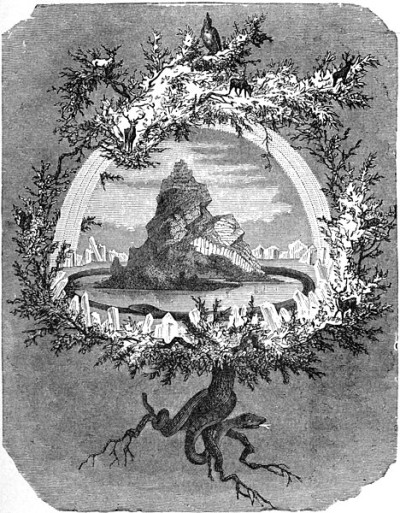
Nor do we know just how the people of the Viking Age believed the tree held the cosmos together. One theory I have heard mentioned several times is that when seeing the Milky Way in the night sky, they believed that was the foliage of the cosmic tree. Just to give sort of a scope of how they viewed their world.
Three Roots of Yggdrasil
Imagine a tree so vast that its branches touch the sky and its roots delve into the underworld. Yggdrasil’s physical appearance is awe-inspiring, with its massive trunk and sprawling branches. At its base, three mighty roots extend into different realms, each drawing water from a distinct well, embodying the tree’s deep connections to various aspects of the cosmos.
Yggdrasil isn’t just a tree; it’s a living, breathing entity. Its atmosphere is one of ancient wisdom and mystical energy. Supernatural elements are woven into its very being, from the magical waters of the wells at its roots to the ethereal light that filters through its leaves. It’s a place where the veil between worlds is thin, and the pulse of the cosmos can be felt.
The Three Wells Sustaining Yggdrasil
The first root is fed by Urdarbrunnr or ‘The Well of Urd’. This well is located in Midgard and it is the most famous of the three. It is the meeting place of the Norns, and each day they pour water and mud from the well onto Yggdrasil so that the great tree remains vital and does not wither away.
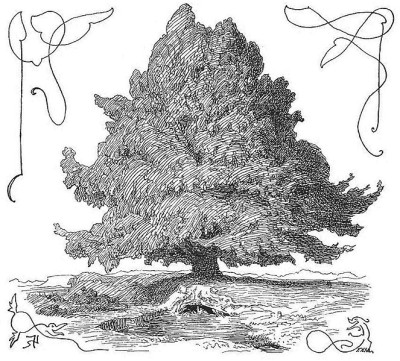
By this well, the destinies of every living creature in the Nine Realms are cast and interwoven. The Norns carve their runes into the bark of the tree, sealing the fates of god and mortal alike therein
The Norns are three in number, named Skuld, Verdandi, and Urd, from whom the well derives its name. The three Norns represent the past, present, and future. Being seers of destiny, they know that the tree will ultimately weaken and usher in the battle of Ragnarok. Nevertheless, they work tirelessly to keep this time at bay.
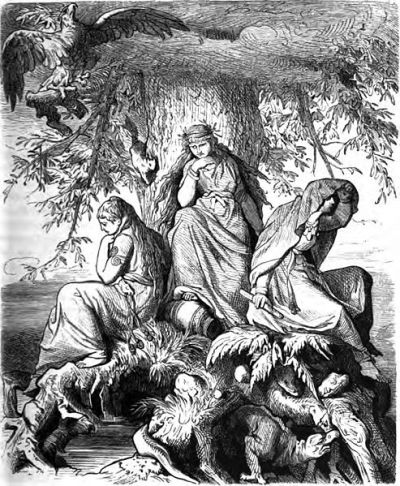
Mimisbrunnr
The second great root reaches deep into Jotunheim, where it draws water from the Mimisbrunnr, ‘Well of Wisdom’. The head of Mimir, god of wisdom, was placed here by Odin, where it drinks eternally from its waters.
The well is said to impart boundless knowledge to all who are permitted to drink from its wisdom. Odin often comes here to consult the wisdom of his uncle’s head that guards the well. It is here that he concedes an eye to the god of knowledge, making sacrifice of his sight into the water so that he might drink and grow wiser.
It is said that when Odin hung from the Yggdrasil in his quest to learn of the runes, he looked down upon a pool that was Mimisbrunnr and found the rune wisdom contained therein.
Hvergelmir
The third and final root is fed by the well called Hvergelmir, “Roaring Cauldron”. It is located in Niflheim, land of endless ice from which the first giants and gods emerged. When ice from Niflheim began to melt on the approach of Muspelheim, the mist from this encounter formed the ancestors of all living creatures in the Nine Realms today.
This well not only nourishes the tree but is said to be the source of all life itself. As dew drops from the great stag Eikthyrnir, it falls into Hvergelmir, and then runs out into all the other rivers. Nidhogg the dragon dwells here by this root with his nest of fellow reptiles.
Contradictions and different stories
I should add that, as so often in Norse mythology, there are different versions of where the roots go. There are also different accounts of the wells that sustain it.
In the poem Grímnismál, Yggdrasil has three roots in Midgard, Jotunheim, and Hel. Völuspá mentions only the Well of Urd beneath it. However, Snorri Sturluson’s Prose Edda describes three wells: the skyward Well of Urd, Hvergelmir in Niflheim, and Mimir’s well in the giants’ realm.
The inhabitants of Yggdrasil
In the immense and mystical Yggdrasil ash tree, a complex and vibrant ecosystem thrives, inhabited by a host of mythical creatures, each with its own unique role and significance.
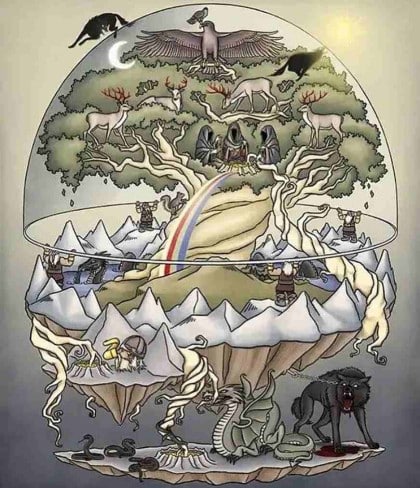
Nidhoggr
At the very roots of Yggdrasil, deep in the earth, dwells Nidhoggr, a fearsome dragon. This malevolent creature ceaselessly gnaws at the roots of the tree, symbolizing the relentless forces of decay and destruction that threaten the stability of the cosmos. Alongside Nidhoggr, numerous other unnamed serpents, often referred to as “Nidhoggr’s brood,” also reside. These serpents contribute to the ominous and destructive presence at the tree’s base, further emphasizing the constant threat to the cosmic order.
Ratatoskr
Traversing the length of Yggdrasil, from its deepest roots to its highest branches, is Ratatoskr. This mischievous squirrel serves as a messenger and gossipmonger, scurrying up and down the trunk. Ratatoskr carries messages between Nidhoggr and the unnamed eagle that resides at the pinnacle of the tree. In doing so he ensures a continuous flow of information, and sometimes, misinformation, between the upper and lower realms.
The Eagle and Vedrfolnir
Perched atop Yggdrasil is an unnamed eagle, a symbol of wisdom and perspective. This eagle keeps a watchful eye over the realms, its vision encompassing the vast expanse of the cosmos. Between the eagle’s eyes sits Vedrfolnir, a hawk that serves as a messenger and observer. Together, the eagle and the hawk represent the higher understanding and the interconnectedness of all realms.
Eikthyrnir
Among the upper branches of Yggdrasil grazes Eikthyrnir, a majestic stag. From its antlers flows dew that drips down into Hvergelmir, to nourish the rivers of the world. This stag symbolizes the life-giving aspects of Yggdrasil, highlighting the tree’s role in sustaining the world’s waters and, by extension, life itself.
Heidrun
Feeding on the foliage of Yggdrasil is Heidrun, a mystical goat whose udders produce an endless supply of mead. This mead is destined for the fallen warriors in Valhalla, providing them with sustenance in the afterlife. Heidrun’s presence underscores Yggdrasil’s role as a source of nourishment and the cyclical nature of life and death.
The Other Stags
Among the lower leaves of Yggdrasil, four other stags—Durathror, Dainn, Duneyrr, and Dvalinn—graze. These stags add to the dynamic environment of the tree, each contributing to the intricate balance of life that Yggdrasil upholds.
Together, these creatures form a complex and interconnected community, each playing a vital role in the life of Yggdrasil. Their interactions and activities not only contribute to the tree’s health and vitality but also reflect the broader themes of Norse mythology, where every being, no matter how small, has a part to play in the grand cosmic drama.
Myths Associated with Yggdrasil
Yggdrasil, the World Tree, stands at the heart of numerous Norse myths, each weaving a rich tapestry of cosmic significance and divine wisdom. Two of the most profound myths associated with Yggdrasil involve Odin’s quest for knowledge and the tree’s role in the cataclysmic events of Ragnarök.
Odin’s Sacrifice for the Runes
One of the most iconic tales associated with Yggdrasil is the story of Odin’s sacrifice. In his unending quest for wisdom, Odin, the Allfather, chose to undergo a tremendous ordeal. He hung himself from a branch of Yggdrasil, impaling himself with his own spear. For nine long nights, he dangled there, suspended between life and death, in a state of self-imposed sacrifice.
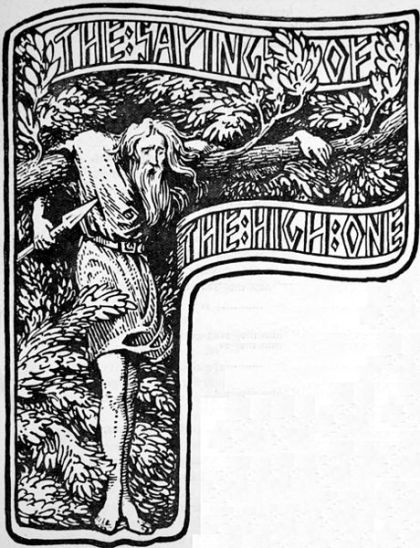
This is described in a famous stanza from the Poetic Edda poem Hávamál.
“I know that I hung on a windy tree
nine long nights,
wounded with a spear, dedicated to Odin,
myself to myself,
on that tree of which no man knows
from where its roots run.”
This was no mere act of endurance; it was a profound spiritual quest. Odin was seeking the secrets of the runes, the mystical symbols that held the power of creation and destruction, wisdom and fate. It was believed that these runes were not just a form of writing but held deep magical properties, governing all aspects of the universe.
As he hung there, peering into the depths of the cosmos and the mysteries of the spirit, Odin finally glimpsed the truths he sought. The runes revealed themselves to him, imparting their wisdom and power. This act of sacrifice and enlightenment is a testament to Odin’s role as a god of wisdom and magic, and it highlights Yggdrasil’s connection to knowledge and the mystical realms.
Yggdrasil and Ragnarök
In the prophecy of Ragnarök, Yggdrasil’s role is both dramatic and symbolic. Ragnarök, often referred to as the “Twilight of the Gods,” is the foretold apocalyptic event in Norse mythology. It is a time of great turmoil and destruction, where many of the gods will meet their end, and the world as it is known will be transformed.
Yggdrasil, being the central axis of the Norse cosmos, stands at the heart of these cataclysmic events. The tree will shake and tremble, signifying the upheaval of the entire universe. Its endurance during Ragnarök is a testament to its strength and resilience. Despite the chaos, Yggdrasil does not fall; it remains steadfast, a symbol of continuity and the cyclical nature of existence.
Furthermore, Yggdrasil is said to provide shelter during these tumultuous times. It is prophesied that two humans, Lif and Lifthrasir, will find refuge within the tree, surviving the destruction of the world. From them, a new world will be born, emerging from the ashes of the old. In this way, Yggdrasil serves not only as a witness to the end but also as a cradle for the new beginning, embodying the eternal cycle of death and rebirth.

Mentions in Ancient Texts
Yggdrasil, the majestic World Tree, is deeply rooted in Norse mythology, with its presence and significance echoed in ancient texts. The tree’s mentions are primarily found in two sources: the Poetic Edda and the Prose Edda, each offering a unique perspective and contributing to the rich tapestry of Yggdrasil’s mythological narrative.
Poetic Edda
Völuspá
In the Poetic Edda poem Völuspá, Yggdrasil is mentioned several times. The seeress recalls the early times, mentioning the tree when it was just a seed. She describes Yggdrasil as:
“An ash I know there stands, Yggdrasill is its name, a tall tree, showered with shining loam. From there come the dews that drop in the valleys. It stands forever green over Urðr’s well.”
This stanza highlights Yggdrasil’s connection to the Norns and the cosmic order. The poem also alludes to Yggdrasil’s role in Ragnarök, describing how the tree shivers and groans as the giant slips free, signaling the onset of the end times.
Hávamál
In Hávamál, Odin’s sacrifice is recounted, where he hung from a tree for nine nights. While Yggdrasil is not explicitly named, it’s widely accepted as the tree in question.
Grímnismál
In Grímnismál, Odin, disguised as Grímnir, provides cosmological lore about Yggdrasil. He mentions the tree’s three roots extending into different realms and the various creatures that inhabit it, including the squirrel Ratatoskr and the serpents beneath. The poem emphasizes Yggdrasil’s suffering and its status as the “noblest of trees.”
Prose Edda
Gylfaginning
In Gylfaginning, Yggdrasil is introduced as the holiest place of the gods. It describes the eagle perched on its branches, the hawk Veðrfölnir, the squirrel Ratatoskr, and the stags that consume its foliage. The text also mentions the Norns who care for Yggdrasil by pouring water and mud from the well Urðarbrunnr over it. The chapter concludes with Yggdrasil’s role in Ragnarök, where it will shake, and nothing will be unafraid in heaven or on earth.
Skáldskaparmál
In Skáldskaparmál, Yggdrasil is indirectly mentioned in a verse by the skald Hallvarðr Háreksblesi, referring to it as the “pole of the earth.” This mention, though brief, underscores Yggdrasil’s significance as the central axis of the cosmos.
These ancient texts paint a vivid picture of Yggdrasil, portraying it as a cosmic entity of immense significance, deeply intertwined with the fate of the gods, the natural world, and the cosmic order.
Frequently Asked Questions
Yggdrasil connects the Nine Realms, including Asgard, Midgard, and Helheim, forming the backbone of the Norse cosmos.
Nidhogg, the malicious dragon, gnaws at the roots, symbolizing the forces of chaos and destruction.
Odin sacrifices himself on this tree, enduring pain to gain the sacred knowledge of the runes.
Despite the chaos of Ragnarok, the World Tree stands resilient, embodying the cycle of destruction and rebirth.
Yes, notably the Well of Urd, where the Norns weave the fates
Gallery
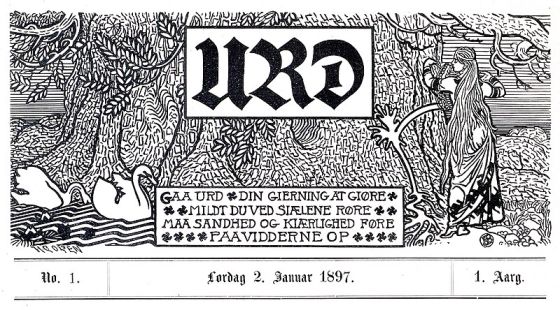 Front page of the first issue of the Norwegian women’s weekly magazine “Urd,”
Front page of the first issue of the Norwegian women’s weekly magazine “Urd,”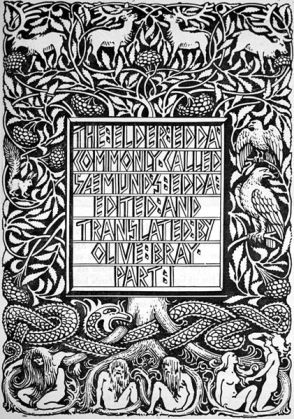 The tree Yggdrasill, complete with Ratatoskr, the four stags, Níðhöggr and Veðrfölnir.
The tree Yggdrasill, complete with Ratatoskr, the four stags, Níðhöggr and Veðrfölnir.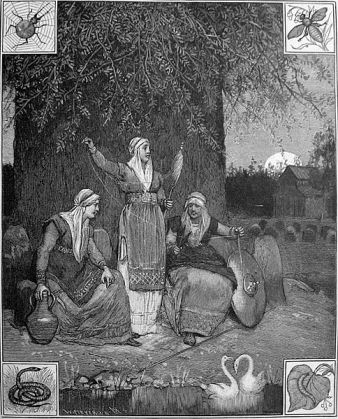 The Norns spin their tapestry at the roots of Yggdrasil.
The Norns spin their tapestry at the roots of Yggdrasil. The world tree Yggdrasil with the assorted animals that live in it and on it.
The world tree Yggdrasil with the assorted animals that live in it and on it.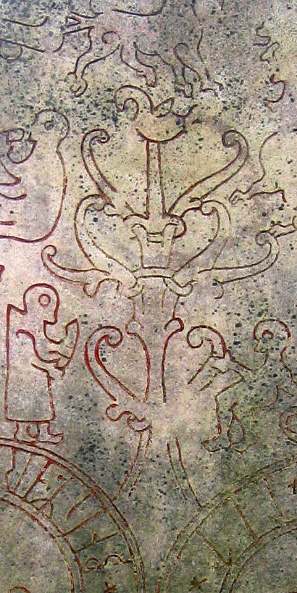 (Yggdrasil) Copy of the destroyed rune stone Gs 19 at Ockelbo church.
(Yggdrasil) Copy of the destroyed rune stone Gs 19 at Ockelbo church.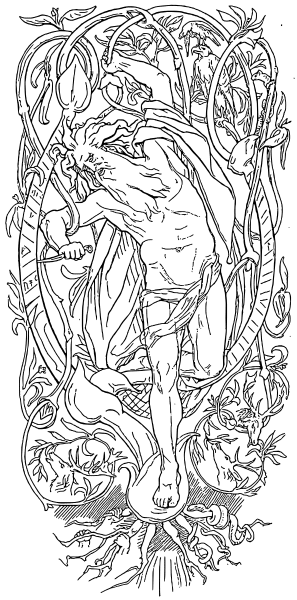 Odin sacrifices himself to himself by hanging from the world tree Yggdrasil
Odin sacrifices himself to himself by hanging from the world tree Yggdrasil
Featured Image Credit: Oluf Bagge, Public domain, via Wikimedia Commons


Thank you for the website.
Correlating the World Tree with the Milky Way is useful. The 5th century Roman writer Macrobius tells us the Milky Way was called the Tree of Life.
The Mayans of South America also called the Milky Way the Tree of Life.
Hi Nancy, thank you so much for taking an interest in the article about Yggdrasil. It is fascinating how so many ancient cultures would converge to reach similar explanations for natural phenomenon even though they had no contact.
Thank you. This helps a lot.
Thanks Kodili, great to know people find our website useful!